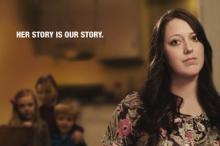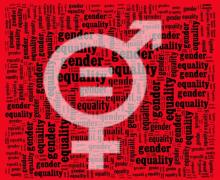shriver report

THE PHRASE “POVERTY in America” still conjures up, for many of us, images of a homeless person begging on an urban street corner or a dilapidated shack in rural Appalachia. But a report this winter presents a very different picture of poverty in the U.S.: “a working mother dashing around getting ready in the morning, brushing her kid’s hair with one hand, and doling out medication to her own aging mother with the other.”
The study released in January by The Shriver Report, “A Woman’s Nation Pushes Back from the Brink,” examined the rates of financial insecurity among U.S. women. The report notes that the average woman is paid 77 cents for every dollar the average man earns, and that closing this wage gap would cut the poverty rate in half for working women and their families.
A few years ago, I was at a global women’s conference looking at the economic dimensions of women’s realities when I first heard the phrase “time poverty,” in an academic talk given by a sociologist. The phrase captured the deeply insidious economic realities that are holding back women’s equality. Most mothers know this reality as we multi-task through our day trying to hold life together for our families. Women everywhere carry the double burden of working outside the home to support their families while still doing the large majority of unpaid domestic work.
The phrase “time poverty” stuck with me and, strangely, captures my reality as a mother of three leading a relatively privileged life. For those of us in the mothering season of life, all over the world, time is not exactly on our side. From sunup to sunset, we find ourselves constantly multitasking, moving as fast as possible and feeling like the hub in the middle of everyone’s wheel. Any tiny setback—a lost pacifier, a sick child—can threaten the whole highly tenuous ecosystem of the day.

“There is no room for hate in love.” – A wise girlfriend once told me to remember that.
Let it land.
Soak it in.
She’s right. But, I would add another line: “There is also no room for judgment and shame in love.”
I just made a film, Paycheck to Paycheck, about an inspiring and courageous woman named Katrina Gilbert. It’s the kind of film that I believe will stay with you long after you see it.

Despite all the modern conveniences of the 21st century, our information-saturated culture, an exhaustive supply of self-help books, and giant advances in medical technology, doesn’t it seem like our society is more stressed, our anxiety higher, and more of our kids prescribed behavior modification drugs?
What if one of the reasons for our strung-out culture was the social, emotional, mental, and physiological outworking of the effects of poverty?
In the latest release of the Shriver Report, Dr. Nadine Burke Harris, founder of the California Pacific Medical Center’s Bayview Child Health Center, has found through medical research and experiences of her patients that the stress of poverty can be manifested in alarming behaviors and predispositions.

Women do a lot of work: Moms, grandmothers, aunties, sisters, daughters, wives, teachers, coaches, and any additional caregiving, mentoring position that fills in our lives. Take a moment to pause and reflect on the number of women who have helped you become the person you are today.
In the latest Shriver Report, NBA star LeBron James writes a meaningful tribute to his mother, Gloria, honoring her dedication as a parent and the sacrifices she made in raising her son as a young single mom. Because Gloria was just 16 years old when LeBron was born, they lived with his grandmother. When Gloria’s mother passed away three years later, she and her young son were on their own.
Still a teenager, Gloria did not have the support, education, or resources to sustain her family. The house was lost, and she and her son moved around frequently — a dozen times in three years — counts LeBron.
He writes that “My mom worked anywhere and everywhere, trying to make ends meet. But through all of that, I knew one thing for sure: I had my mother to blanket me and to give me security. She was my mother, my father, my everything. She put me first. I knew that no matter what happened, nothing and nobody was more important to her than I was. I went without a lot of things, but never for one second did I feel unimportant or unloved.”
In effort to model Gloria’s example of devotion, LeBron now takes an active role by helping other kids of single-parent homes through the LeBron James Family Foundation and the Boys & Girls Clubs of America.
“The truth is that everything I’ve learned about being a parent to my boys … I learned from my mother,” he writes in his letter of appreciation to her. “Everything I know about being loving and caring, and sacrificing and showing up and being present in my children’s lives—I learned all of that from her example.”
Without his mother’s influence, would LeBron be the same LeBron?

(Spoiler—and imperfect analogy — alert to anyone who wasn’t able to sneak these books when they were pre-teens)
If there was one book series that defined my childhood/pre-adolescence, it would be V.C. Andrews’ Flowers in the Attic series. OK, maybe that wasn’t THE book series—after all, there were the Baby-sitters Club books and Sweet Valley High—but in terms of helping to destroy what little innocence I still had, Flowers in the Attic gets top ranking. I mean, I probably didn’t need to be reading books about incest, child abuse, and religious fanaticism when I was 10 years old. But that’s a story for another time.
The Lifetime network has made a film version of Flowers in the Attic that will debut on Saturday night. In anticipation of the remake, I decided to watch the 1987 version starring Kristy Swanson. Besides being struck by how dated it was — think fuzzy lighting, a lot of beiges and pastels, and 80s bangs — the premise seemed outdated even for that time. A recently widowed stay-at-home mother of four finds herself unable to care for her family and must return to her wealthy, estranged parents and beg to get back into her dying father’s good graces (and will). As a condition of her return, she must consent to have her four children locked in the attic and subjected to her mother’s abuse and neglect.
I sometimes forget how much the world has changed in such a short period of time.

Watching the news cycle for the past week or so, I have been pleasantly surprised at how much the issue of poverty is being discussed. There have been many analyses of the successes and failures of the War on Poverty, the 50th anniversary of which we marked last week. But there is one report that has particularly fascinated me — and many others — as it describes how women have been struggling the most against poverty in the United States. In partnership with the Center for American Progress, this year’s Shriver Report: A Woman’s Nation Pushes Back from the Brink examines the problem of poverty as it pertains to women and proposes solutions to eradicate it.
Although those of us who have lived and worked in low-income neighborhoods have witnessed firsthand how poverty affects women and their children, seeing the numbers laid out is still overwhelming.

The third edition of the Shriver Report, a media initiative spearheaded by Maria Shriver to call public attention to women’s evolving role in the home, workplace, and society, was released this month.
With a large body of articles, research, polls, data, and personal stories, the report assesses the unique needs, pressures, and realities women face. Contributors within the faith, health, academic, economic, and political communities are represented, coupled with intentional cultural and social diversity. This gives the Shriver Report a richness of deep and thoughtful voices. The aim is to strike up provocative, meaningful, national conversations on how progressive policies can be better directed to advance gender equality in the United States.
One of the most eye-catching article headlines for me in reading the report was “ Are Women Devalued by Religions?” In the article, sister Joan Chittister remarks on how our assumptions about religion influence our actions, and how the outworking of our actions shapes the norms and policies we guide our lives by. Unfortunately, these assumed beliefs can lead to commonly accepted views that completely distort what God has to say about women.
Sojourners campaigns assistant Anna Hall posted a great piece last week de-bunking 5 myths about the minimum wage. One of these myths — that most minimum wage workers are suburban teenagers — was countered by the facts: nearly two-thirds of minimum wage workers are adult women.
Don’t think of a suburban teenager — think of a single mother working full time while trying to raise her children, care for her family, and make enough to pay rent, probably without any paid sick or personal days (not to mention maternity leave). Could you do that on $15,000 a year?
On Jan. 13, Maria Shriver – who, in addition to her many accomplishments, is the daughter of the statesman widely regarded as the architect of the “War on Poverty” — released a report focusing on the needs of women in the current economy.